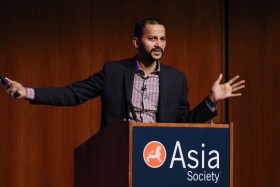On the evening of Friday, November 6th, Kumbh Mela: Mapping the Ephemeral Megacity, a book consisting of collaborative research of a team 50 Harvard University faculty, students, and administrators, made its debut in New York at the Asia Society to an audience of over 200.
Meera Gandhi, founder and CEO of The Giving Foundation, chaired the faculty presentations and panel. She began by sharing her memorable moments from the Kumbh Mela, from dipping in the river with the team of Harvard researchers to capturing the immensity of the Kumbh Mela in photos.
Rahul Mehrotra, Harvard Graduate School of Design, kicked off the faculty presentations with a rapid display of photographs which captured the development of the ephemeral city. He discussed how a land parcel is prepared for the expected 80 million attendees. Furthermore, he explained that often times these urban planners do not have blue prints to use besides oral history shared by past organizers. The map he showed in the following slide may actually be the first of its kind in the history of religious migration. Next, Mehrotra shared the structures of the buildings. The cross sections revealed a simple, study, and sustainable structure that can be reused and resized for different purposes. In fact, the structure of the travelling Kumbh Mela exhibit outside the auditorium was inspired by this architecture. Finally, Mehrotra closed with the end and dismantlement of the Kumbh Mela. Farmers use the land for crops; materials such as street lights are sent across the country for reuse.
Next, Dhruv Kazi, Assistant Professor of the UCSF School of Medicine, spoke about the public health challenges at the Kumbh Mela. His team of medical students digitally tracked over 30,000 of hospital visit entries. The big data allowed his team to instantly discover the median age, problems to health access, and common ailments. To his surprise, the biggest complaint was not diarrhea, but in fact, respiratory problems. The median age of an attendee hovered around 40 years old. Furthermore, females were more likely to visit a central clinic versus a clinic located in the periphery. Visiting a clinic on the outskirts raised the risk of getting lost amongst the crowd.
For the third and final presentation, Tarun Khanna, Jorge Paulo Lemann Professor at the Harvard Business School and Director of SAI, summarized the kind of data and learnings from the interdisciplinary research and imagined the possible applications of the study. He believes the Kumbh Mela presented a ripe opportunity to learn about the beginnings and framework of a megacity, illuminating solutions to natural disasters that require temporary housing.
After the presentations, the speakers stayed for questions from an engaged audience.
Video of the event:

